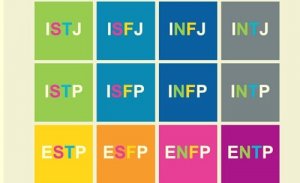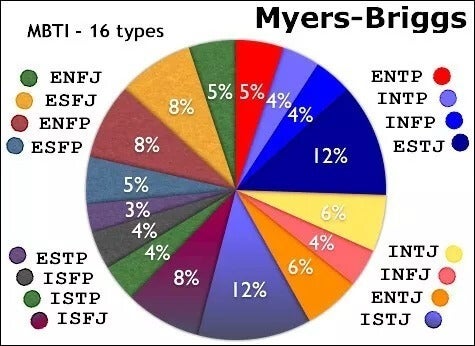Myers Briggs Type Indicator and Jung


Written and verified by the psychologist Valeria Sabater
The Myers-Briggs personality test is one of the most well-known personality instruments. However, it doesn’t have the acceptance of the entire scientific community. This is because it’s not a test that meets the standards of reliability and validity. Nevertheless, the MBTI is still extremely popular.
Who hasn’t read something about the INFJ personality, that profile characterized by introversion, intuition, feeling, and judgment? Also, the INFP personality may resonate with you, as Carl Jung denominated it “the healer”. Anyway, there’s an obvious fact: these letters organized in labels such as INTJ, ESTP, definitely attract people’s attention and arouse curiosity.
It wouldn’t be a mistake to say say that it’s still one of the most used instruments despite its limitations. It’s a sort of inventory in the format of a self-report. In other words, you can do it yourself online and discover what your personality type is. It follows the standard developed by Katherine Briggs and her daughter Isabel Briggs-Myers in 1942.
This instrument is based on Carl Jung’s well-known book Psychological Types. Although you may not know it, Jung was the first to introduce the concepts of introversion and extraversion. Also, he established eight personality types from this dichotomy. The Myers-Briggs personality test draws on this typology and ups it a notch. Continue reading to find out more about this test.
“One does not become enlightened by imagining figures of light, but by making the darkness conscious.”
-Carl Jung-

The Myers-Briggs personality test – purpose, characteristics, and reliability
Isabel Myers and her mother Katherine were fascinated by Jung’s theory when they came across it. Thus, they took it upon themselves to apply his theory in a practical way to help people better understand individual differences. In other words, to deepen the knowledge of human personality and, in turn, facilitate an approach to human potential and limitations.
They began to develop this indicator during World War II. They had already published articles of much interest such as “Meet Yourself: How to find yourself through the personality box” and “Up from barbarism”.
Thus, when they presented the Myers-Briggs personality test for the first time, they did it with the idea of facilitating the labor selection processes. The goal was to help people choose those jobs that could most enhance their happiness and personal fulfillment.
Then, two years later, they improved this instrument a little by publishing a manual on how to use it. In 1956, it changed its name to the current form: Myers-Briggs Type Indicator.
What information does the Myers-Briggs Type Indicator give us?
The Myers-Briggs personality test tells you how to obtain information about your personality type. This test describes up to 16 very specific types.
The objective of the MBTI, therefore, is to help you facilitate self-discovery; to know what’s your way of processing the world and of behaving and of relating. Also, to discover what your strengths are in order to opt for different professional preferences. And even to know how compatible you are with other people.

What does the Myers-Briggs Personality Test measure?
This personality test is built on four scales:
Extraversion (E) – Introversion (I)
Note that everyone has both extraversion and introversion. However, there’s always a greater tendency towards one of them.
Sensing (S) – Intuition (N)
This dimension refers to two ways of interacting with what surrounds you. Thus, sensing people tend to pay close attention to reality and do so through their senses.
However, the intuitive get carried away by more abstract factors such as emotions, patterns, and impressions. Also, the latter are more imaginative and thoughtful.
Thinking (T) – Feeling (F)
This dimension offers information on how you make decisions. Some are more logical and objective (reasoning and thinking) and others are more emotional.
Judging (J) – Perceiving (P)
The final scale tells you how you interpret your surroundings and how you decide. Thus, there are those who judge and always make firm decisions. On the opposite side, there are those who are more flexible, perceptive, sensitive, and adaptable.
Finally, according to the results you obtain in each of these four dimensions, a code will come to shape into a series of letters that will define your personality style:
- ISTP – The craftsman
- ISFJ – The protector
- ISFP – The artist
- INFJ – The lawyer
- INFP – The healer
- INTJ – The architect
- INTP – The thinker
- ESTP – The persuasive
- ESTJ – The director
- ESFP – The brave
- ESFJ – The caregiver
- ENFP – The champion
- ENFJ – The giver
- ENTP – The converter
- ENTJ – The commander

Application and reliability of the Myers-Briggs Personality Test
As we mentioned at the beginning of the article, the Myers-Briggs personality test isn’t an instrument with great acceptance from “experts”. This is a popular and controversial instrument. To begin with, its descriptions are somewhat diffuse to describe behavior.
So much so that the scientific community points out that this instrument falls within what they refer to as the Forer effect. That is, it’s just a description to feel instantly identified.
Similarly, note that despite its criticisms, its low reliability, and validity, this instrument is often used in the vocational area.
As an Allen Hammer research study explains, it’s usually applied in many schools to help students figure out their vocation. It’s also a recurring test in the field of personal development as well as the test that people do online find out more about themselves.
However, it’ll always be more successful if a specialized professional explains the results and ultimately offers you adequate guidance. Anyway, nobody can deny that it’s still an attractive and interesting resource.
The Myers-Briggs personality test is one of the most well-known personality instruments. However, it doesn’t have the acceptance of the entire scientific community. This is because it’s not a test that meets the standards of reliability and validity. Nevertheless, the MBTI is still extremely popular.
Who hasn’t read something about the INFJ personality, that profile characterized by introversion, intuition, feeling, and judgment? Also, the INFP personality may resonate with you, as Carl Jung denominated it “the healer”. Anyway, there’s an obvious fact: these letters organized in labels such as INTJ, ESTP, definitely attract people’s attention and arouse curiosity.
It wouldn’t be a mistake to say say that it’s still one of the most used instruments despite its limitations. It’s a sort of inventory in the format of a self-report. In other words, you can do it yourself online and discover what your personality type is. It follows the standard developed by Katherine Briggs and her daughter Isabel Briggs-Myers in 1942.
This instrument is based on Carl Jung’s well-known book Psychological Types. Although you may not know it, Jung was the first to introduce the concepts of introversion and extraversion. Also, he established eight personality types from this dichotomy. The Myers-Briggs personality test draws on this typology and ups it a notch. Continue reading to find out more about this test.
“One does not become enlightened by imagining figures of light, but by making the darkness conscious.”
-Carl Jung-

The Myers-Briggs personality test – purpose, characteristics, and reliability
Isabel Myers and her mother Katherine were fascinated by Jung’s theory when they came across it. Thus, they took it upon themselves to apply his theory in a practical way to help people better understand individual differences. In other words, to deepen the knowledge of human personality and, in turn, facilitate an approach to human potential and limitations.
They began to develop this indicator during World War II. They had already published articles of much interest such as “Meet Yourself: How to find yourself through the personality box” and “Up from barbarism”.
Thus, when they presented the Myers-Briggs personality test for the first time, they did it with the idea of facilitating the labor selection processes. The goal was to help people choose those jobs that could most enhance their happiness and personal fulfillment.
Then, two years later, they improved this instrument a little by publishing a manual on how to use it. In 1956, it changed its name to the current form: Myers-Briggs Type Indicator.
What information does the Myers-Briggs Type Indicator give us?
The Myers-Briggs personality test tells you how to obtain information about your personality type. This test describes up to 16 very specific types.
The objective of the MBTI, therefore, is to help you facilitate self-discovery; to know what’s your way of processing the world and of behaving and of relating. Also, to discover what your strengths are in order to opt for different professional preferences. And even to know how compatible you are with other people.

What does the Myers-Briggs Personality Test measure?
This personality test is built on four scales:
Extraversion (E) – Introversion (I)
Note that everyone has both extraversion and introversion. However, there’s always a greater tendency towards one of them.
Sensing (S) – Intuition (N)
This dimension refers to two ways of interacting with what surrounds you. Thus, sensing people tend to pay close attention to reality and do so through their senses.
However, the intuitive get carried away by more abstract factors such as emotions, patterns, and impressions. Also, the latter are more imaginative and thoughtful.
Thinking (T) – Feeling (F)
This dimension offers information on how you make decisions. Some are more logical and objective (reasoning and thinking) and others are more emotional.
Judging (J) – Perceiving (P)
The final scale tells you how you interpret your surroundings and how you decide. Thus, there are those who judge and always make firm decisions. On the opposite side, there are those who are more flexible, perceptive, sensitive, and adaptable.
Finally, according to the results you obtain in each of these four dimensions, a code will come to shape into a series of letters that will define your personality style:
- ISTP – The craftsman
- ISFJ – The protector
- ISFP – The artist
- INFJ – The lawyer
- INFP – The healer
- INTJ – The architect
- INTP – The thinker
- ESTP – The persuasive
- ESTJ – The director
- ESFP – The brave
- ESFJ – The caregiver
- ENFP – The champion
- ENFJ – The giver
- ENTP – The converter
- ENTJ – The commander

Application and reliability of the Myers-Briggs Personality Test
As we mentioned at the beginning of the article, the Myers-Briggs personality test isn’t an instrument with great acceptance from “experts”. This is a popular and controversial instrument. To begin with, its descriptions are somewhat diffuse to describe behavior.
So much so that the scientific community points out that this instrument falls within what they refer to as the Forer effect. That is, it’s just a description to feel instantly identified.
Similarly, note that despite its criticisms, its low reliability, and validity, this instrument is often used in the vocational area.
As an Allen Hammer research study explains, it’s usually applied in many schools to help students figure out their vocation. It’s also a recurring test in the field of personal development as well as the test that people do online find out more about themselves.
However, it’ll always be more successful if a specialized professional explains the results and ultimately offers you adequate guidance. Anyway, nobody can deny that it’s still an attractive and interesting resource.
All cited sources were thoroughly reviewed by our team to ensure their quality, reliability, currency, and validity. The bibliography of this article was considered reliable and of academic or scientific accuracy.
- Fairfield, KD (2012). Indicador de tipo Myers-briggs (MBTI). En Casos y ejercicios de desarrollo y cambio organizacional (págs. 309–312). SAGE Publications Inc. https://doi.org/10.4135/9781483387444.n39
- Greenhaus, J., Callanan, G. y Hammer, AL (2013). Indicador Myers-Briggs. En Enciclopedia del desarrollo profesional . SAGE Publications, Inc. https://doi.org/10.4135/9781412952675.n185
This text is provided for informational purposes only and does not replace consultation with a professional. If in doubt, consult your specialist.







